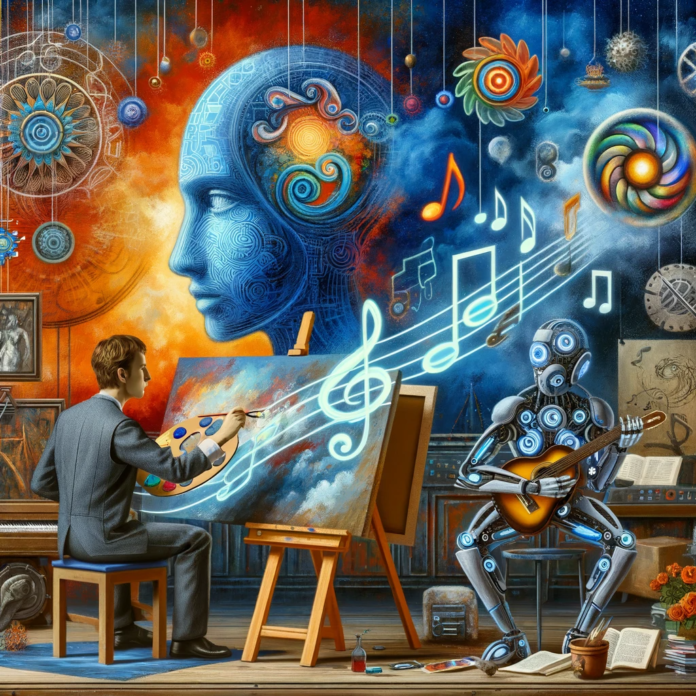Introduction
In the fascinating realm of creativity, a profound and stirring question emerges: Has artificial intelligence (AI) surpassed human creativity? This debate, intricate and multifaceted, weaves together the rapidly evolving world of AI with the timeless essence of human artistry. From the days of simple computer programs to today’s sophisticated neural networks, AI’s journey into the creative domain has been nothing short of extraordinary. As it continues to make significant strides, AI’s role in creative processes becomes increasingly prominent, sparking intricate discussions about the nuances of “AI creativity” versus “human creativity.” This exploration into the advancements and implications of AI in the field of creativity seeks to unravel this complex and captivating subject, delving into the historical evolution, case studies, ethical considerations, and future prospects of AI in creativity.
The Evolution of AI in Creative Fields
AI’s journey into creative domains is a testament to technological innovation and artistic exploration. Initially, AI systems were rudimentary, capable of basic tasks without much creative flair. However, with advancements in machine learning and neural networks, AI began to make significant inroads into the arts. In the visual arts, systems like DeepDream and GANs (Generative Adversarial Networks) have produced mesmerizing artworks that redefine traditional artistry. In music, AI-generated compositions not only mimic the works of classical masters but also create novel symphonies, pushing the boundaries of musical composition. Similarly, in writing, AI tools have crafted poetry and narratives with a surprising depth of language and emotion. The design world, too, has witnessed AI’s prowess, with innovative concepts and layouts emerging from AI-driven software. These advancements signify a paradigm shift in how we perceive AI’s role in creativity, challenging our conventional understanding of artistic creation.
Case Studies: AI Achievements in Creativity
The creative accomplishments of AI are exemplified in various groundbreaking instances. For instance, in the art world, AI-generated paintings have been sold for considerable sums at prestigious auction houses, blurring the distinctions between human and machine-made art. In music, AI algorithms have composed pieces that are indistinguishable from human-composed works, showcasing AI’s potential in emulating and even innovating within the musical sphere. In literature, AI has produced narratives and poems that are coherent, engaging, and stylistically varied, illustrating AI’s growing competence in language arts. These instances not only highlight AI’s capabilities in mimicking human creativity but also raise fundamental questions about the essence and nature of creativity itself.
Comparing AI and Human Creativity
When comparing AI to human creativity, key differences emerge. Human creativity is deeply rooted in emotional depth, cultural nuances, and a reservoir of personal experiences – aspects that AI cannot fully replicate or understand. Human artists draw upon their life experiences, emotional states, and cultural backgrounds to create works that resonate on a personal and collective level. AI, conversely, excels in processing vast amounts of data, identifying patterns, and creating outputs based on learned information. However, this raises questions about the originality and emotional depth of AI creations. AI’s reliance on existing human-made works as a foundation for its output prompts a discussion on the authenticity and novelty of its creative endeavors.
The Role of AI in Enhancing Human Creativity
AI’s role in the creative world is not limited to independent creation; it also serves as a powerful tool for enhancing human creativity. Collaborations between AI and human artists, writers, and musicians have led to innovative works that merge human intuition with AI’s computational prowess. These collaborative projects, often termed “AI-assisted creativity,” foster a symbiotic relationship where AI’s strengths in data processing and pattern recognition augment human creativity. This evolving partnership is redefining the creative landscape, leading to novel forms of expression and artistic innovation previously unattainable.
Ethical and Philosophical Considerations
The integration of AI into creative processes brings forth significant ethical and philosophical dilemmas. One of the most pressing issues is the ownership and copyright of AI-generated content. As AI systems create artworks, music, or literature, the question arises: Who holds the rights to these creations? The authenticity of AI creations is another critical topic, as it challenges traditional notions of what constitutes “original” art. Additionally, the impact of AI on human artists and the creative industry at large is a subject of ongoing debate. These ethical considerations require careful examination and thoughtful discourse to navigate the complex interplay between technology and art.
Future Prospects: Will AI Continue to Grow in Creative Fields?
Looking forward, AI’s trajectory in the realm of creativity appears to be on an upward curve. With continuous advancements in machine learning algorithms and neural networks, AI is poised to become even more sophisticated in its creative capabilities. The future of AI in creativity is likely to witness a deeper integration of AI tools in artistic processes, potentially revolutionizing the ways in which art is conceived and executed. These developments suggest an evolving landscape where AI not only assists but also inspires new forms of creative expression.
Conclusion
The inquiry into whether AI has surpassed human creativity is intricate and multi-layered. AI’s capabilities in generating creative works are undeniably impressive; however, it lacks the emotional depth and cultural context that are inherent in human creativity. The evolving narrative of AI advancements in the creative realm suggests a future marked by closer collaboration between AI and humans, where each amplifies the strengths of the other. In this dynamic interplay, the future of creativity may well be a harmonious blend of human imagination and AI innovation, opening new horizons in the world of art and creativity.


